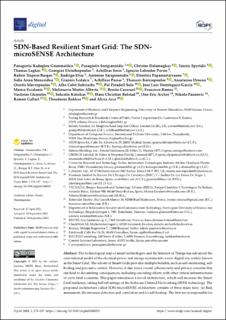| dc.contributor.author | Radoglou-Grammatikis, Panagiotis | |
| dc.contributor.author | Sarigiannidis, Panagiotis | |
| dc.contributor.author | Dalamagkas, Christos | |
| dc.contributor.author | Spyridis, Yannis | |
| dc.contributor.author | Lagkas, Thomas | |
| dc.contributor.author | Efstathopoulos, Georgios | |
| dc.contributor.author | Sesis, Achilleas | |
| dc.contributor.author | Labrador Pavon, Ignacio | |
| dc.contributor.author | Trapero Burgos, Ruben | |
| dc.contributor.author | Diaz, Rodrigo | |
| dc.contributor.author | Sarigiannidis, Antonios | |
| dc.contributor.author | Papamartzivanos, Dimitris | |
| dc.contributor.author | Menesidou, Sofia Anna | |
| dc.contributor.author | Ledakis, Giannis | |
| dc.contributor.author | Pasias, Achilleas | |
| dc.contributor.author | Kotsiopoulos, Thanasis | |
| dc.contributor.author | Drosou, Anastasios | |
| dc.contributor.author | Mavropoulos, Orestis | |
| dc.contributor.author | Colet Subirachs, Alba | |
| dc.contributor.author | Paradell Sola, Pol | |
| dc.contributor.author | Domínguez-García, Jose Luis | |
| dc.contributor.author | Escalante, Marisa | |
| dc.contributor.author | Martin Alberto, Molinuevo | |
| dc.contributor.author | Caracuel, Benito | |
| dc.contributor.author | Ramos, Francisco | |
| dc.contributor.author | Gkioulos, Vasileios | |
| dc.contributor.author | Katsikas, Sokratis | |
| dc.contributor.author | Bolstad, Hans Christian | |
| dc.contributor.author | Archer, Dan-Eric | |
| dc.contributor.author | Paunovic, Nikola | |
| dc.contributor.author | Gallart, Ramon | |
| dc.contributor.author | Rokkas, Theodoros | |
| dc.contributor.author | Arce, Alicia | |
| dc.date.accessioned | 2022-05-09T14:01:03Z | |
| dc.date.available | 2022-05-09T14:01:03Z | |
| dc.date.created | 2021-11-30T18:56:45Z | |
| dc.date.issued | 2021 | |
| dc.identifier.citation | Digital. 2021, 1 (4), 173-187. | en_US |
| dc.identifier.issn | 2673-6470 | |
| dc.identifier.uri | https://hdl.handle.net/11250/2994853 | |
| dc.description.abstract | The technological leap of smart technologies and the Internet of Things has advanced the conventional model of the electrical power and energy systems into a new digital era, widely known as the Smart Grid. The advent of Smart Grids provides multiple benefits, such as self-monitoring, self-healing and pervasive control. However, it also raises crucial cybersecurity and privacy concerns that can lead to devastating consequences, including cascading effects with other critical infrastructures or even fatal accidents. This paper introduces a novel architecture, which will increase the Smart Grid resiliency, taking full advantage of the Software-Defined Networking (SDN) technology. The proposed architecture called SDN-microSENSE architecture consists of three main tiers: (a) Risk assessment, (b) intrusion detection and correlation and (c) self-healing. The first tier is responsible for evaluating dynamically the risk level of each Smart Grid asset. The second tier undertakes to detect and correlate security events and, finally, the last tier mitigates the potential threats, ensuring in parallel the normal operation of the Smart Grid. It is noteworthy that all tiers of the SDN-microSENSE architecture interact with the SDN controller either for detecting or mitigating intrusions. Keywords: anomaly detection; blockchain; cybersecurity; energy management; honeypots; intrusion detection; islanding; privacy; Smart Grid; Software Defined Networking | en_US |
| dc.language.iso | eng | en_US |
| dc.publisher | MDPI | en_US |
| dc.rights | Navngivelse 4.0 Internasjonal | * |
| dc.rights.uri | http://creativecommons.org/licenses/by/4.0/deed.no | * |
| dc.title | SDN-Based Resilient Smart Grid: The SDN-microSENSE Architecture | en_US |
| dc.type | Peer reviewed | en_US |
| dc.type | Journal article | en_US |
| dc.description.version | publishedVersion | en_US |
| dc.source.pagenumber | 173-187 | en_US |
| dc.source.volume | 1 | en_US |
| dc.source.journal | Digital | en_US |
| dc.source.issue | 4 | en_US |
| dc.identifier.doi | 10.3390/digital1040013 | |
| dc.identifier.cristin | 1962133 | |
| dc.relation.project | Norges forskningsråd: 310105 | en_US |
| dc.relation.project | EU – Horisont Europa (EC/HEU): 833955 — SDN-microSENSE | en_US |
| cristin.ispublished | true | |
| cristin.fulltext | original | |
| cristin.qualitycode | 1 | |

